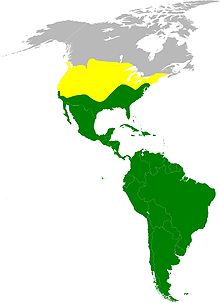
Back نسر رومي Arabic نسر رومى ARZ Cathartes aura AST Пуйков лешояд Bulgarian টার্কি শকুন Bengali/Bangla Urubu penn ruz Breton Zopilot capvermell Catalan Cathartes aura CEB ᏑᎵ CHR Kondor krocanovitý Czech
| Turkey vulture Temporal range:
| |
|---|---|

| |
| A turkey vulture in Orange Walk District, Belize | |
| Scientific classification | |
| Domain: | Eukaryota |
| Kingdom: | Animalia |
| Phylum: | Chordata |
| Class: | Aves |
| Order: | Cathartiformes |
| Family: | Cathartidae |
| Genus: | Cathartes |
| Species: | C. aura
|
| Binomial name | |
| Cathartes aura | |

| |
| Range of C. aura[image reference needed] Summer only range Year-round range
| |
| Synonyms | |
|
Vultur aura Linnaeus, 1758 | |
The turkey vulture (Cathartes aura) is the most widespread of the New World vultures.[2] One of three species in the genus Cathartes of the family Cathartidae, the turkey vulture ranges from southern Canada to the southernmost tip of South America. It inhabits a variety of open and semi-open areas, including subtropical forests, shrublands, pastures, and deserts.[1]
Like all New World vultures, it is not closely related to the Old World vultures of Europe, Africa, and Asia. However, the two groups strongly resemble each other due to convergent evolution.
The turkey vulture is a scavenger and feeds almost exclusively on carrion.[3] It finds its food using its keen eyes and sense of smell, flying low enough to detect the gasses produced by the beginnings of the process of decay in dead animals.[3] In flight, it uses thermals to move through the air, flapping its wings infrequently. It roosts in large community groups. Lacking a syrinx—the vocal organ of birds—its only vocalizations are grunts or low hisses.[4] It nests in caves, hollow trees, or thickets. Each year it generally raises two chicks, which it feeds by regurgitation.[5] It has very few natural predators.[6] In the United States, the vulture receives legal protection under the Migratory Bird Treaty Act of 1918.[7]
- ^ a b BirdLife International (2018). "Cathartes aura". IUCN Red List of Threatened Species. 2018: e.T22697627A131941613. doi:10.2305/IUCN.UK.2018-2.RLTS.T22697627A131941613.en. Retrieved 11 November 2021.
- ^ "Turkey vulture". Britannica Concise Encyclopedia. Archived from the original on 2020-08-23. Retrieved 2007-10-14.
- ^ a b Cite error: The named reference
ADWwas invoked but never defined (see the help page). - ^ Miskimen, Mildred (January 1957). "Absence of Syrinx in the Turkey Vulture (Cathartes aura)" (PDF). The Auk. 74 (1): 104–105. doi:10.2307/4082043. JSTOR 4082043. Archived (PDF) from the original on 2016-03-04. Retrieved 2006-10-24.
- ^ Cite error: The named reference
Ferguswas invoked but never defined (see the help page). - ^ Cite error: The named reference
snyderwas invoked but never defined (see the help page). - ^ Cite error: The named reference
FWSwas invoked but never defined (see the help page).
© MMXXIII Rich X Search. We shall prevail. All rights reserved. Rich X Search
